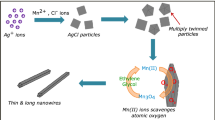Abstract
High electrical conductivity, high transparency and mechanical flexibility are important properties in generations of transparent conductive electrodes. Currently the most efficient and widely used transparent conductive material is Indium Tin Oxide. Searching for alternative materials has been being followed due to the lack of Indium resources, ITO inflexibility and its high manufacturing costs. In the present study, silver nanowire as a promising alternative to ITO was synthesized through polyol method and then silver nanowire layer was applied on glassy substrates using drop-casting method. Adhesion between the layer and the substrate was established using polyaniline. Characterization of the thin film was conducted using X-ray diffraction methods, field emission scanning electron microscopy, UV–Vis spectroscopy and a four-point probe. The results show that corrective deoxidation operations and separation of nanowires from nanoparticles, leads to an increase in transparency from 79 to 81.4% and decrease sheet resistance of 89 to 76 Ω/□.







Similar content being viewed by others
Data availability
All data generated or analysed during this study are included in this published article.
References
X. Li, J. Zhou, D. Yan, Y. Peng, Y. Wang, Q. Zhou, K. Wang, Effects of concentration and spin speed on the optical and electrical properties of silver nanowire transparent electrodes. Materials 14, 2219 (2021)
Y. Zhang, J.N. Guo, D. Xu, Y. Sun, F. Yan, one-pot synthesis and purification of ultralong silver nanowires for flexible transparent conductive electrodes. ACS Appl. Mater. Interfaces 9, 25465–25473 (2017)
F. Qiang, M. Jinlei, L. Xuhua, Z. Xingwei, Z. Wenxiao, T. Mingwei, Z. Shiefeng, Q. Lijun, Z. Xueji, Biomimetic hierarchically silver nanowire interwoven MXene mesh for flexible transparent electrodes and invisible camouflage electronics. ACS Nano Lett. 22, 740–750 (2022)
M. Oh, W. Jin, H. Jeong, M. Jeong, J. Kang, H. Kim, Silver nanowire transparent conductive electrodes for high-efficiency III-nitride light-emitting diodes. Sci. Rep. 5, 13483 (2015)
D.H. Kim, N.H. Park, T.W. Kim, Highly efficient flexible organic light-emitting devices based on PEDOT:PSS electrodes doped with highly conductive Pyronin B. Nano Energy 65, 104027 (2019)
S. Fahad, H. Yu, L. Wang, Recent progress in the synthesis of silver nanowires and their role as conducting materials. Mater. Sci. 54, 997–1035 (2019)
F. Fiévet, F. Ammar-Merah, R. Brayner, The polyol process a unique method for easy access to metal nanoparticles with tailored sizes, shapes and compositions. Chem. Soc. Rev. 47, 5187–5233 (2018)
L. Zhang, T. Song, L. Shi, N. Wen, Z. Wu, C. Sun, D. Jiang, Z. Guo, Recent progress for silver nanowires conducting film for flexible electronics. Nanostruct. Chem. 11, 323–341 (2021)
J. Han, J. Yang, W. Gao, H. Bai, Ice-Templated, Large-area silver nanowire pattern for flexible transparent electrode. Adv. Func. Mater. 31, 2010155 (2021)
S. Lim, Cu-based multilayer transparent electrodes: a low-cost alternative to ITO electrodes in organic solar cells. Sol. Energy Mater. Sol. Cells 101, 170–175 (2013)
R. Yin, Sh. Yang, Q. Li, Sh. Zhang, H. Liu, J. Han, Ch. Liu, Flexible conductive Ag nanowire nanofibril hybrid nanopaper for strain and temperature sensing applications. Sci. Bull. 65, 899–908 (2020)
R. Chen, S.R. Das, Ch. Jeong, M.R. Khan, D.B. Janes, M.A. Alam, Co-Percolating graphene-wrapped silver nanowire network for high performance, highly stable transparent conducting electrodes. Adv Funct. Mater. 23, 5150 (2016)
J. Kim, S. Kim, H. Kil, Y. Kim, J. Park, Highly conformable, transparent electrodes for epidermal electronics. Nano Lett. 18, 4531–4540 (2018)
F. Xu, W. Xu, B. Mao, W. Shen, Y. Yu, R. Tan, W. Song, Preparation and cold welding of silver nanowire based transparent electrodes with optical transmittances >90% and sheet resistances <10 ohm/sq. J. Colloid Interface Sci. 512, 201–208 (2018)
B. Bari, J. Lee, T. Jang, P. Won, S. Ko, Kh. Alamgir, M. Arshadd, L. Guo, Simple hydrothermal synthesis of very-long and thin silver nanowires and their application in high quality transparent electrodes. Mater. Chem. A 29, 11141 (2016)
S. Na, S. Kim, Efficient and flexible ITO-free organic solar cells using highly conductive polymer anodes. Adv. Mater. 20, 4061–4067 (2018)
I. Hu, Sh. Tu, Zh. Huang, Y. Wei, Silver nanowires: synthesis technologies, growth mechanism and multifunctional applications. Mater. Sci. Eng. 223, 1–23 (2017)
M. Talukdar, E. Baker, Conductivity studies on silver oxide. Solid State Commun. 7, 309–310 (1969)
B. L’vov, Kinetics and mechanism of thermal decomposition of silver oxide. Thermochim. Acta 333, 13–19 (1999)
M.T. Molares, A.G. Balogh, T. Cornelius, R. Neumann, C. Trautmann, Fragmentation of nanowires driven by Rayleigh instability. Appl. Phys. 85, 5337–5339 (2004)
G. Haacke, New figure of merit for transparent conductors. Appl. Phys. 47, 4086 (1976)
Funding
The authors have not disclosed any funding.
Author information
Authors and Affiliations
Contributions
All authors contributed to the study conception and design. Material preparation, data collection and analysis were performed by MS, AE and AAA. The first draft of the manuscript was written by MS and all authors commented on previous versions of the manuscript. All authors read and approved the final manuscript.
Corresponding author
Ethics declarations
Conflict of interest
The authors declare that they have no conflicts of interest.
Ethical approval
This study was not supported financially by any organizations.
Human and animal rights
This article does not contain any studies involving human participants performed by any of the authors.
Additional information
Publisher's Note
Springer Nature remains neutral with regard to jurisdictional claims in published maps and institutional affiliations.
Rights and permissions
Springer Nature or its licensor (e.g. a society or other partner) holds exclusive rights to this article under a publishing agreement with the author(s) or other rightsholder(s); author self-archiving of the accepted manuscript version of this article is solely governed by the terms of such publishing agreement and applicable law.
About this article
Cite this article
Saeidi, M., Eshaghi, A. & Aghaei, A.A. Electro-optical properties of silver nanowire thin film. J Mater Sci: Mater Electron 34, 110 (2023). https://doi.org/10.1007/s10854-022-09621-8
Received:
Accepted:
Published:
DOI: https://doi.org/10.1007/s10854-022-09621-8




